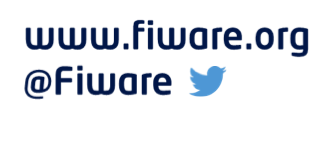Accessing third-party servicies using IdM tokens
Application Mashup (WireCloud) course @ http://edu.fiware.org



Presenter Notes
Accessing third-party servicies using IdM tokens
Introduction
Presenter Notes
Introduction
Sometimes you need to access to a third-party service whose authentication is managed using the same IdM service used by the WireCloud instance. In those cases, you can make use of the support provided by WireCloud for injecting the OAuth2 token obtained from the IdM server into the requests made from your widgets/operators.
WireCloud provides this token injection support through the WireCloud's proxy, which is the component in charge of injecting the token. If you want to use the tokens obtained from the IdM, you must use the WireCloud's proxy (e.g. by using the
MashupPlatform.http.makeRequestmethod). WireCloud doesn't provide support for reading OAuth2 tokens from widgets/operators.
Note: This document uses the headers names available on WireCloud 0.9.1+ for simplicity, but previous versions of WireCloud use other names. See the latest slide for more info.
Presenter Notes
Introduction
How to use the token injection support
All the configuration about how to inject the OAuth2 token into your requests is
provided using HTTP headers that will be consumed by the WireCloud's proxy. The
main header is: FIWARE-OAuth-Token. This header should be added to any
requests (providing true as value) in which we want to inject an OAuth2 token.
Take into account that anonymous users doesn't have a valid OAuth2 token. Also, if you are running a custom instance of WireCloud it can be configured to support several auth backends. In that case, some user won't be associated with an IdM account. You can check if the currently logged user has an associated IdM token by running the following code:
MashupPlatform.context.get('fiware_token_available');
Presenter Notes
Accessing third-party servicies using IdM tokens
Injecting IdM tokens...
Presenter Notes
Injecting IdM tokens...
into HTTP headers
Usually you will want to inject the OAuth2 token into an HTTP header, this can
be accomplished by using the FIWARE-OAuth-Header-Name header. Tipically,
you will want to add the token into the X-Auth-Token header (as used by Open
Stack) or into the Authorization header (as dictated by the OAuth2 RFC). If
you inject the OAuth2 token into the Authorization header, WireCloud will add
the token type prefix accordingly (e.g. Bearer).
Example:
MashupPlatform.http.makeRequest(url, { requestHeaders: { "FIWARE-OAuth-Token": "true", "FIWARE-OAuth-Header-Name": "X-Auth-Token" }, ... });
Presenter Notes
Injecting IdM tokens...
as GET parameters
Another common place for injecting the OAuth2 token is into a GET parameter on
the URL. This kind of injection is configured using the
FIWARE-OAuth-GET-Parameter header.
Example:
MashupPlatform.http.makeRequest(url, { requestHeaders: { "FIWARE-OAuth-Token": "true", "FIWARE-OAuth-GET-Parameter": "access_token" }, ... });
This will add an access_token GET parameter into the URL containing the OAuth2
token of the currently logged user.
Presenter Notes
Injecting IdM tokens...
into the body of the request
Finally, the proxy can inject OAuth2 tokens into the body of the request. To do
so, you have to provide the pattern to be searched and replaced with the OAuth2
token using the FIWARE-OAuth-Body-Pattern header.
Example:
MashupPlatform.http.makeRequest(url, { method: 'POST', postBody: JSON.stringify({token: "%fiware_token%"}), requestHeaders: { "FIWARE-OAuth-Token": "true", "FIWARE-OAuth-Body-Pattern": "%fiware_token%" }, ... });
This will search for any %fiware_token% ocurrence in the body of the request
and replace it with the OAuth2 token of the user.
Presenter Notes
Accessing third-party servicies using IdM tokens
Using the dashboard owner IdM token
Presenter Notes
Using the dashboard owner IdM token
WireCloud 0.7.2+ provides experimental support for using the OAuth2 token of the
owner of the dashboard instead of using the OAuth2 token of the current logged
user. To do so, add the FIWARE-OAuth-Source header into your request and use
the workspaceowner value. This header can be used in combination with any of
the previously presented headers: FIWARE-OAuth-GET-Parameter,
FIWARE-OAuth-Header-Name or FIWARE-OAuth-Body-Pattern.
Example:
MashupPlatform.http.makeRequest(url, { requestHeaders: { "FIWARE-OAuth-Token": "true", "FIWARE-OAuth-Header-Name": "X-Auth-Token", "FIWARE-OAuth-Source": "workspaceowner" }, ... });
Presenter Notes
Deprecated header names
Version 0.9.0 and below of WireCloud uses another set of the header names.
They were prefixed with X- and had a dash inside the FIWARE word. For example,
FIWARE-OAuth-Token was named X-FI-WARE-OAuth-Token. In addition, the header
for indicating the body pattern was further restructured.
| WireCloud 0.9.1+ | WireCloud 0.9.0 and bellow |
|---|---|
| FIWARE-OAuth-Body-Pattern | X-FI-WARE-OAuth-Token-Body-Pattern |
| FIWARE-OAuth-GET-Parameter | X-FI-WARE-OAuth-GET-Parameter |
| FIWARE-OAuth-Header-Name | X-FI-WARE-OAuth-Header-Name |
| FIWARE-OAuth-Source | X-FI-WARE-OAuth-Source |
Old names can still be used but will be removed in WireCloud 1.1
Presenter Notes


